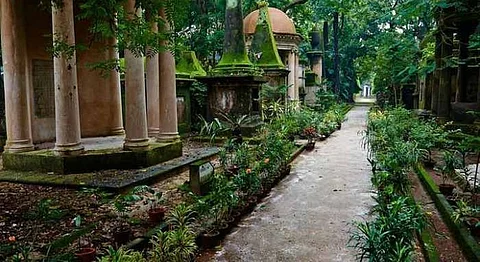
- HOMEGROWN WORLD
- #HGCREATORS
- #HGEXPLORE
- #HGVOICES
- #HGSHOP
- CAREERS
- ABOUT US
- CONTACT US

With India’s diversity comes a number of burial customs—from Hindu funeral pyres to Parsis laying out the dead to feed birds of prey, it should be no surprise that we were also home to one of the world’s first non-church cemeteries. The Park Street Cemetery was established in 1767 in Kolkata and is now a site preserved by the Archaeological Survey of India.
Previously known as the ‘Great Christian Burial Ground’, it houses the tombs of distinguished Europeans who settled in Kolkata during the British colonial rule. The name was then changed to ‘Park Street Cemetery’, after the private deer park built by Sir Elijah Impey around that area. In 1840, the cemetery was closed for active use due to the lack of burial space. As a result, an enormous new cemetery was opened in a place called the Lower Circular Road Cemetery nearby.
According to Kolkata City Tours this cemetery of eight acres with tall trees and wildflowers is enclosed by high brick walls on Park Street, now known as Mother Teresa Sarani. The cemetery has approximately 1600 tombs with cenotaphs, tablets and epitaphs. The tombs are mostly made of sand-stone while the architectural designs of the tombs reflect classical European styles; Romanesque cupolas, Grecian urns, pyramids, obelisks, cairns and sarcophagi. The sarcophagi are designed in an unique Hindu style with black basalt carvings on the frontal fascia that resembles miniature replicas of Orissan rekha deul. The gravestones are a mix of Gothic and Indo-Saracenic style. Renovation of these tombs began in mid 2000, but some are still under renovation today.
According to New York based digital magazine Roads And Kingdoms Park Street Cemetery has some interesting European personalities buried in its grounds—Sir William Jones who died in 1794 was a Supreme Court Judge. He established the Asiatic Society in Kolkata, 1784, which still stands on Park Street today. He was also a renowned linguist and is said to have translated important Sanskrit scriptures such as the Bhagavad Gita.
Another rather interesting personality is Colonel Charles Stuart, who was a cadet in the Bengal Army. His affinity towards the native culture of India made him idiosyncratic in the eyes of his peers. In 1778, he wrote an article that urged the military to start wearing Indian attire and recommended upper class white women in Calcutta to choose the sari over their stuffy Victorian corsets for the former according to Stuart was “the most alluring dress in the world.” He was deeply drawn to Hinduism and thus his tomb has been shaped to mimic a Hindu temple with lotus motifs that stand out amidst a largely Gothic cemetery.
A star personality that lays there is Rose Aylmer, who died in 1800. She was the the wife of the famous poet Henry Landor. It is said that his famous ‘Ode to Rose’ serves as her epitaph.
A cemetery isn’t gothic enough without macabre happenings and sure enough Park Street Cemetery has its own haunted graves. A small, pyramid-shaped structure deep in the undergrowth is called the ‘bleeding tomb.’ Legend has it that it oozes a blood-like substance during the monsoons. This memorial belongs to the Dennison family, all of whom died within weeks of one another. The cause of their deaths remain unrecorded.
If one can look past this eerie setting, Park Street Cemetery is a historical wonderland hidden in a rabbit hole, waiting to be discovered!
To read more about Park Street Cemetery by Roads And Kingdoms, click here.
Feature Image Source: Travel +Leisure
